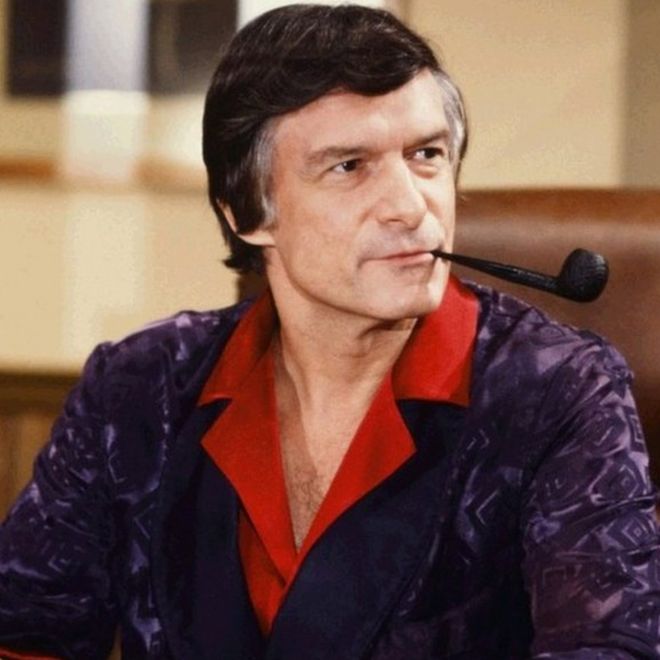 GETTY IMAGES
GETTY IMAGES
Hugh Hefner created a fantasy world for millions of men but unlike most of his readers, actually got to live the dream.
He successfully tapped into a new generation of Americans who were enjoying rising standards of living in the boom years of the 1950s and 60s.
A political activist and philanthropist, he produced not just a magazine, but a whole lifestyle.
And in Playboy's famous bow-tie-wearing rabbit he launched one of the most recognised brands of the 20th Century.
Hugh Marston Hefner was born in Chicago on 9 April 1926, the son of two teachers with strong religious views.
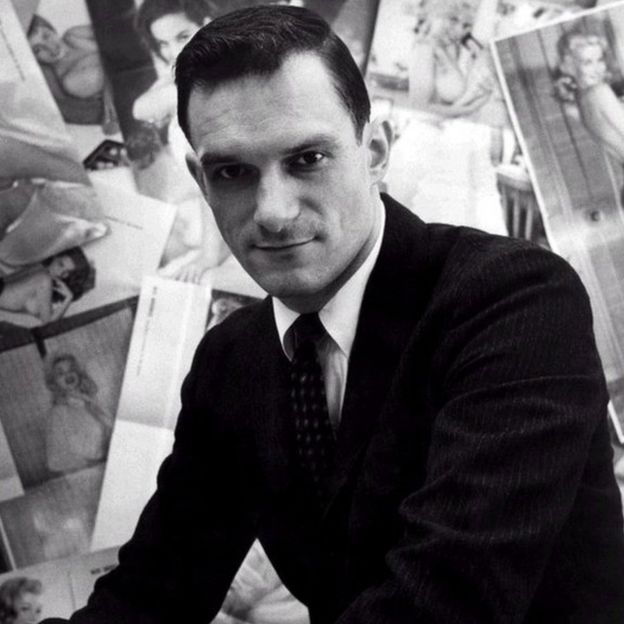 REX FEATURES
REX FEATURES
After serving in the US Army as a writer, he graduated with a degree in psychology before going to work as a copywriter for the men's magazine, Esquire.
In 1953 he borrowed $8,000 to produce the first issue of Playboy. Hefner was so worried that the magazine would not sell that he left the date off the cover.
Photographs
His mother contributed $1,000. "Not because she believed in the venture," Hefner later said, "but because she believed in her son."
He'd originally planned to name the new publication Stag Party, but changed his mind at the last minute.
"Can you imagine a chain of clubs staffed by girls wearing antlers."
 GETTY IMAGES
GETTY IMAGES
The first edition featured a set of nude photographs of Marilyn Monroe that Hefner had bought for $500. They had originally been shot for a 1949 calendar.
Whether by luck or judgement, Hefner's timing was just right. The launch of Alfred Kinsey's reports on human sexual behaviour challenged conventional beliefs about sexuality and raised subjects that, until then, had been taboo.
Kinsey was the researcher," Hefner later remarked, "I was the pamphleteer."
Rabbit
Middle-class American society in the 1950s was notoriously strait-laced and the combination of tastefully photographed women and intellectually stimulating articles appealed to the post-war urban male.
"I never thought of it as a sex magazine," Hefner later recalled. "I always thought of it as a lifestyle magazine in which sex was one important ingredient."
It was an unqualified success, selling more than 50,000 copies within weeks. Hefner had found a niche in the market for men's publications, which was then dominated by hunting, shooting and fishing periodicals.
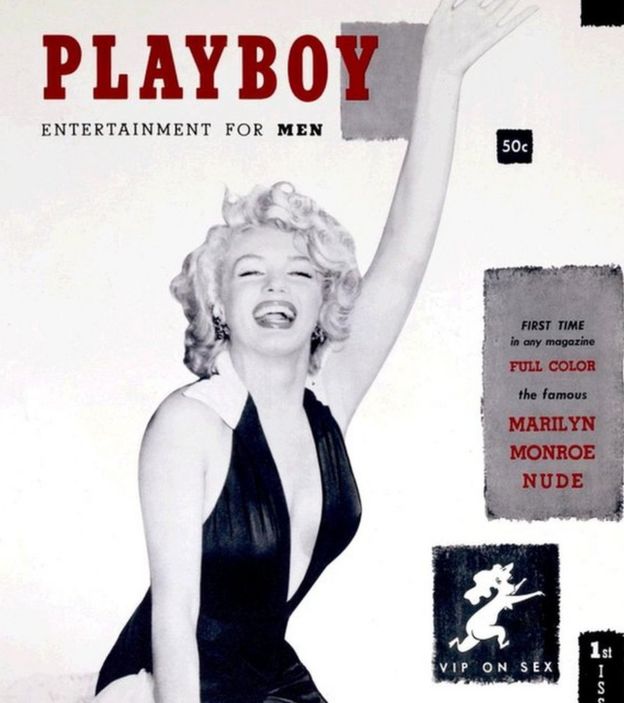 PLAYBOY
PLAYBOY
The second issue saw the appearance of the bow-tie-wearing rabbit, which was designed by the magazine's art director Art Paul. It would appear on a host of products over the following decades.
In 1955 Hefner published a short story by the writer Charles Beaumont, about straight men facing persecution in a world where homosexuals were the majority.
Finest contemporary writing
In response to a flood of angry letters, Hefner replied: "If it was wrong to persecute heterosexuals in a homosexual society then the reverse is wrong too."
In later years he would become an advocate for same-sex marriage describing it as "a fight for all our rights".
Hefner's editorial stance was in tune with the changes in society as the magazine campaigned for liberal drugs laws and the right to abortion.
 GETTY IMAGES
GETTY IMAGES
For the next 20 years, Playboy dominated its market, with circulation peaking at over seven million in the early 1970s, when a survey suggested that a quarter of all male college students in America were buying the magazine.
At the time it contained some of the finest contemporary writing in the magazine market, with Saul Bellow, Arthur C Clarke, Norman Mailer and Gore Vidal among the regular contributors.
Luxury and indulgence
The articles appeared sandwiched between the obligatory photographs of beautiful women, although far more tastefully shot than many of Playboy's more downmarket competitors.
The centre spread entitled Playmate of the Month featured some famous names including Jayne Mansfield and Pamela Anderson, while other celebrities, including Bo Derek, Kim Basinger, Farrah Fawcett and Madonna, have been happy to pose for the magazine.
The photographs of Jayne Mansfield provoked Hefner's arrest and a prosecution for obscenity in 1963 but the jury was unable to reach a verdict.
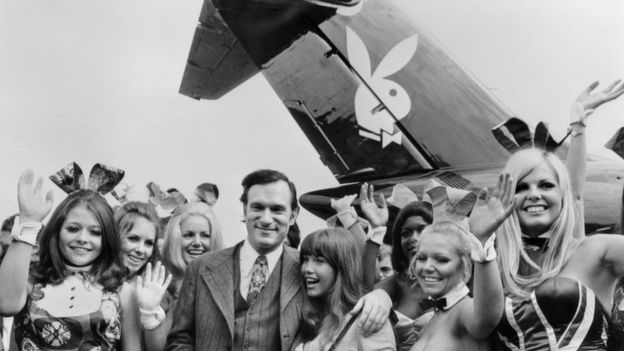 GETTY IMAGES
GETTY IMAGES
Hefner set out to exploit the success of his magazine with the opening of the first Playboy club in Chicago in 1960, which introduced the Playboy bunny waitresses.
The relaxation of gaming laws in the UK opened up another opportunity and Hefner opened three casinos in the UK. By 1981 they were contributing all of Playboy's worldwide profits.
At this time Hefner was living a life of luxury and indulgence in his two Playboy mansions, accompanied by an ever-changing cast of celebrities and pneumatic girlfriends, and shuttling between them in his personalised DC9, the Big Bunny.
Sexually explicit
Hefner's fortunes went into a major decline during the 1980s. The British authorities shut down the UK casinos following a series of irregularities, effectively cutting Playboy's income.
A year later a casino in Atlantic City, New Jersey, was closed after Hefner was judged by the state gaming board to be an unsuitable person to hold a licence.
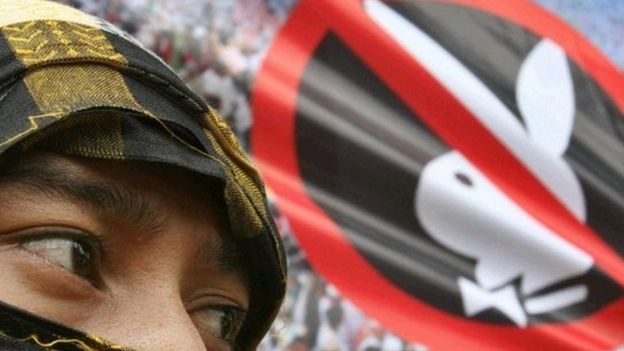 GETTY IMAGES
GETTY IMAGES
Playboy magazine too was failing as more sexually explicit competitors competed for space on the newsstands and traditional Playboy readers got older and moved on.
In a further personal blow Hefner suffered a stroke in 1985 and four years later passed the daily control of Playboy Enterprises to his daughter Christie.
In 1989, at the age of 63, Hefner married one of his playmates, 27-year-old Kimberley Conrad. The marriage lasted for 10 years and produced two children.
Libertarian
The 90s saw a revival in Playboy's fortunes as Christie Hefner took the company into new and more profitable areas including cable TV.
Hefner, meanwhile, had - in his own words - discovered Viagra, and spent his days in his mansion, dressed in silk pyjamas and surrounded by a half-dozen or so live-in female companions.
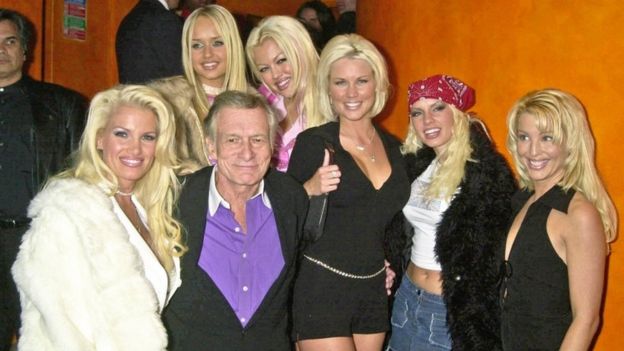 GETTY IMAGES
GETTY IMAGES
In 2012 he married his third wife, Crystal Harris, when he was 86 - 60 years older than his bride.
A libertarian by nature, Hefner's Playboy Foundation continued to support freedom of expression and First Amendment rights. He also donated large sums of money to the Democratic Party, including Hillary Clinton's presidential campaign.
He was a keen supporter of conservation organisations and, perhaps appropriately, had a species of rabbit, Sylvilagus palustris hefneri, named in his honour.
In his later years Hugh Hefner was much ridiculed as the elderly man who still surrounded himself with beautiful young women.
But in Playboy he created a lifestyle which was in tune with the aspirations of a large section of post-war American society. The feminist Camille Paglia called him "one of the principal architects of the social revolution".
"I am a kid in a candy store," Hefner famously said. "I dreamed impossible dreams, and the dreams turned out beyond anything I could possibly imagine. I'm the luckiest cat on the planet."
No comments:
Post a Comment